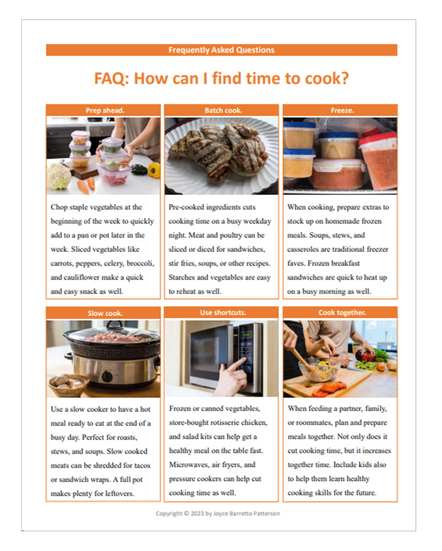Enhance Your Telehealth and Nutrition Education Toolkit
- Joyce Patterson
- Aug 2, 2024
- 4 min read
How do you translate the complicated concepts of health and nutrition into information that your patients can understand, relate to, and apply in their daily lives?
Artfully!
A skilled educator understands that different people learn in different ways--listening, seeing, writing, doing, reading--and many likely benefit from a variety of modes. Therefore, a variety of teaching strategies are required for an effective education. Hands-on activities, demonstrations, pictures and videos, printed materials, and discussion are often used in combination.
But there's more to telehealth than education. The age-old statement, "I know what to do, I'm just not doing it," is evidence that information, alone, does not elicit motivation. The threat of disease, alone, does not always maintain change. For many, the effort of planning healthy meals and being physically active can feel daunting and time-consuming, which can prevent them from taking even the first steps.
Over the years, I have found that certain strategies elicit the following statements:
"Nobody ever explained it to me that way before." I often hear this after I provide some key points of the disease process. Too often, patients are shown their lab values and told what medications to take or what diet to follow, with little information about how either of those things relate to the changes in their body. For example, regarding nutrition, people will say, "They just told me how many carbs I can eat." Or, "I was told to avoid FODMAPs."
However, when more information is provided--for example, why glucose stays in the blood longer and how diet relates to insulin resistance; or how foods like cheeseburgers and pizza can interfere with the breakdown of LDL-cholesterol; or how undigested FODMAPs draw water into the colon leading to diarrhea--people can better visualize why to apply the relevant nutrition recommendations.
"Oh thank goodness, I can eat again." All too often, healthcare providers give patients lists of food and the impression that they should avoid all of them. Understandably, people end up feeling like "I can't eat anything."
In most cases, the Plate Method is an excellent strategy for teaching balanced meal planning. With 3/4 of the plate filled with non-starchy vegetables and high fiber carbs, it is high in plant foods. With only quarter-plate portions of starches, legumes or fruit, it is low in carbohydrates. With a quarter-plate protein, a plate method meal can provide as much as 25g protein, sometimes more. When patients see a variety of examples, they are reassured that they can eat a variety of food and flavors, and that they are not limited to grilled chicken and salad.
When patients see a variety of Plate Method examples, they are reassured that they can eat a variety of food and flavors. Add these pics to your toolkit.
"I can do that." The distance between understanding information and applying it can feel wide and insurmountable. From planning ahead to prepping vegetables to finding affordable foods, there are many perceived barriers to healthy eating. People often struggle with multiple barriers--and not all topics can be comprehensively covered in one visit. However, handouts with actionable ideas can empower patients to try new things, develop skills, gain confidence, and ultimately make changes that last.
Telehealth Slides and Handouts
The new book Think Like A Dietitian: A Nutrition Counseling Starter Kit includes ready-to-go, downloadable patient education materials that can be used in telehealth or in person, for individuals or for group classes.
The materials apply the basic tenets of health communications and health literacy. Plain language and colorful, engaging graphics present health and nutrition information in ways that are engaging and easy to understand.
Educational slides are available for the most common reasons for referral:
Prediabetes and type 2 diabetes
Heart health
Chronic kidney disease
The low FODMAP diet
Weight management
Examples of Downloadable Slides
The handouts address some of the most frequently asked questions in nutrition counseling, providing information that is both relatable and practical. They are designed to educate the reader on why and how to balance meals and snacks, with actionable steps, cooking tips, and recipe ideas. These PDFs can be sent to clients electronically following a telehealth visit, or printed and handed out in person. Topics include:
What can I have for breakfast?
What can I have for snacks?
How can I find time to cook?
How can I eat healthy on a budget?
How much protein do I need?
How can I stay motivated?
How should I track my food?
Examples of Printable Handouts
Designed for Patients and Providers
For patients, these materials succinctly and comprehensively provide the information that they want to know, while empowering them with information that they need to know, including:
Basic metabolism.
The development of each condition.
How each condition affects metabolism.
How food can help--and hurt--various conditions.
The importance of balanced meal planning.
Practical tips, recipe ideas, and resources for support.
With these materials, providers will:
Save valuable time - No need to write new materials or search for images. The work is already done!
Answer frequently asked questions quickly - Breakfast and snack ideas, cooking tips, nutrition assistance programs...just click "print" or "send."
Build their telehealth toolkit - The more tools available the better.
An Affordable Deal
For under $40, all of these materials are included with the book Think Like A Dietitian: A Nutrition Counseling Starter Kit. The book also covers the following topics:
How to structure a nutrition counseling session, from getting a patient to open up to empowering them with information and strategies for self‑care.
Strategies for the provider to address personal challenges such as cultivating empathy, implicit bias, and cultural competence.
Routine eating patterns and challenges reported in nutrition counseling, such as night eating, emotional eating, and more.
Frequently asked questions on topics including diabetes, heart disease, kidney disease, irritable bowel syndrome, and weight counseling.
Special issues in health education
Enhance your nutrition education toolkit and order your copy today! The book is available at Routledge, Amazon, Barnes & Noble and other booksellers.




































Comments